The Enter Facebook Password pop-up scam is a fake message that created in order to trick you into entering your Facebook login/password. If your internet browser started randomly displaying the “Enter Facebook Password” scam, then most probably that ‘ad-supported’ software (also known as adware) was installed on your MAC.
This adware alters the Safari, Firefox and Google Chrome settings to display a large number of unwanted advertisements. These ads can be varied: pop-up windows, boxes, in-text ads, different sized banners, fake alerts and so on.
It is likely that you might be worried with the ad supported software that causes multiple misleading “Enter Facebook Password” alerts and popups. You should not disregard this unwanted software. The ad-supported software might not only display unwanted advertisements, but reroute your web browser to misleading and malicious websites.
What is more, the adware can analyze your surfing, and gain access to your user data and, afterwards, can transfer it to third parties. Thus, there are more than enough reasons to remove “Enter Facebook Password” fake pop-up message from your Apple Mac.
To find out how to get rid of “Enter Facebook Password” pop-up message, we suggest to read the few simple steps added to this post below. The guide was prepared by experienced security professionals who discovered a method to remove adware out of the Apple Mac.
Remove “Enter Facebook Password” pop up scam
In the step-by-step guide below we will have a look at the ‘ad supported’ software and how to remove “Enter Facebook Password” from Mozilla Firefox, Chrome and Safari browsers for Apple Mac, natively or by using a few free removal utilities. Read it once, after doing so, please print this page as you may need to shut down your web browser or restart your machine.
To remove “Enter Facebook Password”, complete the following steps:
- How to remove “Enter Facebook Password” pop-up message without any software
- How to remove “Enter Facebook Password” fake message with free applications
- Stop “Enter Facebook Password” pop up scam and other annoying webpages
- Prevent “Enter Facebook Password” popup scam from installing
- Finish words
How to remove “Enter Facebook Password” pop-up message without any software
The useful removal tutorial for the “Enter Facebook Password” pop-up message. The detailed procedure can be followed by anyone as it really does take you step-by-step. If you follow this process to remove “Enter Facebook Password” fake message let us know how you managed by sending us your comments please.
Delete suspicious apps through the Finder
Check out the Finder (Applications section) to see all installed apps. If you see any unknown and suspicious programs, they are the ones you need to uninstall.
Open Finder and click “Applications”.

It will display a list of all apps installed on your machine. Scroll through the all list, and uninstall any suspicious and unknown applications. Right click to suspicious program and choose “Move to Trash”. Another solution is drag the program from the Applications folder to the Trash.
Most important, scroll through the all list, and move to trash any unknown applications. Don’t forget, choose Finder -> Empty Trash.
Remove “Enter Facebook Password” fake message from Google Chrome
Use the Reset web-browser utility of the Chrome to reset all its settings like new tab page, startpage and default search provider to original defaults. This is a very useful tool to use, in the case of browser redirects to intrusive ad sites such as “Enter Facebook Password”.
First open the Chrome. Next, press the button in the form of three horizontal dots (![]() ).
).
It will display the Google Chrome menu. Select More Tools, then click Extensions. Carefully browse through the list of installed extensions. If the list has the addon signed with “Installed by enterprise policy” or “Installed by your administrator”, then complete the following steps: Remove Chrome extensions installed by enterprise policy.
Open the Google Chrome menu once again. Further, press the option named “Settings”.

The internet browser will show the settings screen. Another way to open the Google Chrome’s settings – type chrome://settings in the browser adress bar and press Enter
Scroll down to the bottom of the page and press the “Advanced” link. Now scroll down until the “Reset” section is visible, as shown on the image below and click the “Reset settings to their original defaults” button.

The Google Chrome will display the confirmation dialog box as shown in the figure below.

You need to confirm your action, click the “Reset” button. The internet browser will start the task of cleaning. Once it is finished, the browser’s settings including newtab, search engine by default and home page back to the values that have been when the Google Chrome was first installed on your machine.
Remove “Enter Facebook Password” pop-up scam from Mozilla Firefox
Resetting Mozilla Firefox web-browser will reset all the settings to their original settings and will remove “Enter Facebook Password” pop up scam, malicious add-ons and extensions. It will keep your personal information like browsing history, bookmarks, passwords and web form auto-fill data.
First, start the Mozilla Firefox. Next, click the button in the form of three horizontal stripes (![]() ). It will display the drop-down menu. Next, click the Help button (
). It will display the drop-down menu. Next, click the Help button (![]() ).
).

In the Help menu click the “Troubleshooting Information”. In the upper-right corner of the “Troubleshooting Information” page click on “Refresh Firefox” button as shown in the figure below.

Confirm your action, click the “Refresh Firefox”.
Remove “Enter Facebook Password” popup from Safari
If you find that Safari web browser settings such as new tab page, search provider by default and startpage having been replaced by ad supported software that causes multiple misleading “Enter Facebook Password” alerts and popups, then you may revert back your settings, via the reset web browser procedure.
Click Safari menu and choose “Preferences”.

It will open the Safari Preferences window. Next, click the “Extensions” tab. Look for unknown and suspicious addons on left panel, choose it, then click the “Uninstall” button. Most important to delete all unknown extensions from Safari.
Once complete, click “General” tab. Change the “Default Search Engine” to Google.

Find the “Homepage” and type into textfield “https://www.google.com”.
How to remove “Enter Facebook Password” fake message with free applications
The ad-supported software can hide its components which are difficult for you to find out and delete completely. This can lead to the fact that after some time, the adware that causes multiple misleading “Enter Facebook Password” alerts and popups once again infect your Apple Mac. Moreover, We want to note that it is not always safe to remove ‘ad supported’ software manually, if you don’t have much experience in setting up and configuring the operating system. The best way to search for and delete adware is to use free malware removal programs.
How to get rid of “Enter Facebook Password” with MalwareBytes Free
Manual “Enter Facebook Password” pop up message removal requires some computer skills. Some files that created by the adware can be not completely removed. We suggest that run the MalwareBytes AntiMalware that are completely free your Apple Mac of ad-supported software. Moreover, the free application will help you to remove malicious software, potentially unwanted software, hijackers and toolbars that your MAC OS can be infected too.

MalwareBytes Anti-Malware can be downloaded from the following link.
21175 downloads
Author: Malwarebytes
Category: Security tools
Update: September 10, 2020
When the download is finished, run it and follow the prompts. Click the “Scan” button . MalwareBytes Free program will scan through the whole computer for the adware which made to show misleading “Enter Facebook Password” pop up within your browser. Depending on your Apple Mac, the scan can take anywhere from a few minutes to close to an hour. All detected items will be marked. You can remove them all by simply click “Remove Selected Items” button.
The MalwareBytes is a free program that you can use to delete all detected folders, files, malicious services and so on.
Stop “Enter Facebook Password” pop up scam and other annoying webpages
It’s important to run adblocker programs such as AdGuard to protect your Apple Mac from malicious web sites. Most security experts says that it is okay to stop ads. You should do so just to stay safe! And, of course, the AdGuard may to stop “Enter Facebook Password” and other intrusive web pages.

- Installing the AdGuard is simple. First you will need to download AdGuard from the link below.
AdGuard for Mac download
3888 downloads
Author: © Adguard
Category: Security tools
Update: January 17, 2018
- Once the download is done, launch the downloaded file. You will see the “Setup Wizard” program window. Follow the prompts.
- When the installation is done, press “Skip” to close the installation program and use the default settings, or click “Get Started” to see an quick tutorial that will allow you get to know AdGuard better.
- In most cases, the default settings are enough and you don’t need to change anything. Each time, when you start your MAC OS, AdGuard will start automatically and block unwanted pop-up ads, “Enter Facebook Password” scam, as well as other malicious or misleading web-pages.
Prevent “Enter Facebook Password” popup scam from installing
Most of fake alerts such as “Enter Facebook Password” scam come from browser toolbars, web-browser extensions and bundled software. In many cases, these items claim itself as applications that improve your experience on the Internet by providing a fast and interactive homepage or a search engine that does not track you. Remember, how to avoid the unwanted programs. Be cautious, launch only reputable programs which download from reputable sources. NEVER install any unknown and suspicious apps.
Finish words
Now your MAC system should be clean of the adware that causes misleading “Enter Facebook Password” pop-up on your web browser. We suggest that you keep AdGuard (to help you stop unwanted pop-up ads and unwanted malicious sites) and MalwareBytes (to periodically scan your computer for new malware, browser hijackers and adware). Make sure that you have all the Critical Updates recommended for Mac operating system. Without regular updates you WILL NOT be protected when new browser hijackers, malicious apps and adware are released.
If you are still having problems while trying to get rid of “Enter Facebook Password” pop up message from your browser, then ask for help here.

















